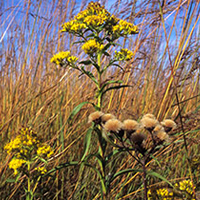RiddellŌĆÖs goldenrod
Scientific name: Solidago riddellii

Cover photo credit: Allen Woodliffe
Status
Special Concern
ŌĆ£Special ConcernŌĆØ means the species lives in the wild in ░─├┼ė└└¹, is not endangered or threatened, but may become threatened or endangered due to a combination of biological characteristics and identified threats.
Date added to the Species at Risk in ░─├┼ė└└¹ List
The RiddellŌĆÖs Goldenrod was already assessed as a species of special concern when the Endangered Species Act took effect in 2008.
What it looks like
RiddellŌĆÖs Goldenrod belongs to the well-known group of wildflowers in the Aster family that produce showy, yellow flowers mostly in late summer. This perennial plant produces flat-topped to rounded flower clusters made up of approximately 30 to 450 tiny flowering heads. The stems grow singly or in small bunches from a thickened base, and can reach up to a metre in height. The narrow leaves tend to curve back and downward and those at or near the base of the plant are folded along the middle vein.
Where it lives
RiddellŌĆÖs Goldenrod prefers open tallgrass prairie habitat with moist to wet calcium-rich soils. In ░─├┼ė└└¹, it also occurs in roadside ditches and along railway right-of-ways.
Where itŌĆÖs been found in ░─├┼ė└└¹
RiddellŌĆÖs Goldenrod range extends across the midwest United States, from Ohio west to South Dakota and south to Arkansas. In Canada, populations are restricted to southwestern ░─├┼ė└└¹ and southeastern Manitoba.
What threatens it
In Canada, the conversion of prairie habitat to farmland and urban development has contributed to RiddellŌĆÖs GoldenrodŌĆÖs decline. Some populations along abandoned railway lines are threatened by a combination of recreational use such as hiking, and natural succession by other plants.
Action we are taking
Special concern species do not receive species or habitat protection.
What you can do
Report a sighting
- Report a sighting of an endangered animal or plant to the Natural Heritage Information Centre. Photographs with specific locations or mapping coordinates are always helpful.
Volunteer
- Volunteer with your local nature club or provincial park to participate in surveys or stewardship work focused on species at risk.
Be a good steward
- Private land owners have a very important role to play in species recovery. You may be eligible for stewardship programs that support the protection and recovery of species at risk and their habitats.
- RiddellŌĆÖs Goldenrod and many other species at risk depend on healthy grassland prairies, a very rare habitat in ░─├┼ė└└¹. Learn more about these habitats, the species that depend on them, and what you can do to help at .
Report illegal activity
- Report any illegal activity related to plants and wildlife to 1-877-TIPS-MNR (847-7667).
Quick facts
- RiddellŌĆÖs Goldenrod has the potential to self-pollinate but it is primarily an out-breeder, pollinated by a variety of flies, bees, wasps, and moths.
- RiddellŌĆÖs Goldenrod survives as an underground woody stem during winter. Seeds are dispersed by the wind, but plants may also reproduce by sending up shoots from the underground stem.